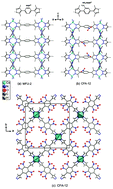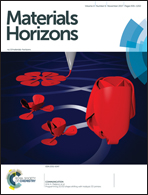Magnetodielectric coupling in a non-perovskite metal–organic framework†
Abstract
Multiferroicity and magnetodielectric coupling in metal–organic frameworks (MOFs) are rare and so far restricted mainly to formate-based systems with a perovskite structure. In the course of this work we designed a tetragonal framework [Co(C16H15N5O2)], exhibiting spin-chains of Co2+ ions, which are bridged by an organic linker containing a dipolar nitrobenzene moiety. This compound shows relaxor-like ferroelectricity at 100 K, which is followed by the onset of complex magnetic order at 15 K, indicative of weak ferromagnetism. The clear anomaly of the dielectric constant at the magnetic ordering transition indicates magnetodielectric coupling, which is also confirmed by magnetic-field dependent dielectric measurements. Both weak ferromagnetism and magnetodielectric couplingprobably result from a significant Dzyaloshinskii–Moriya interaction, which cants the spin structure and locally breaks inversion symmetry. We document that the introduction of dipolar nitrobenzene as a building block into the crystal structure paves the way to designing new multiferroic and magnetodielectric MOFs.



 Please wait while we load your content...
Please wait while we load your content...